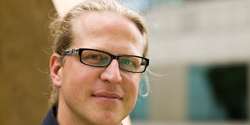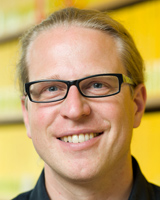Creating New Worlds through Research
Jakob Stix conducts fundamental research in arithmetic geometry.
Jakob Stix likes to get to the bottom of things. Especially if it's numbers he's dealing with. Stix, who recently completed his habilitation, is head of a junior research group at the Mathematics Center Heidelberg (MATCH), where he focuses on arithmetic geometry: he investigates the properties of numbers and algebraic equations and translates his questions into the geometrical language of curves and surfaces.

Stix' focus area is étale fundamental groups - algebraic objects that can be assigned to geometric objects. “I'm interested in any arithmetic structure that can be described with fundamental groups”, explains the scientist. He translates questions about numbers from one mathematical language into another and back in order to learn more about them. His work, and mathematical research in general, is characterised by the fact that the tools - in this case the fundamental groups - become the centre of attention in the attempt to solve a problem. “The problems are sometimes easily put into words, but it may take centuries to solve them”, explains the mathematician. “The important thing for us is the mathematics created between the formulation of a conjecture and its solution - and what we learn about the structure of mathematics in the process.”
Stix conducts fundamental research. It is impossible to say if and how his findings will ever be translated into practical application. Experience has shown that it may take a long time for results of fundamental mathematical research to find their way into application, the scientist explains. The mathematical foundation of today's JPEG file format and of the data compression of digital cameras, for instance, was already developed in the early 20th century. Stix' research focus of arithmetic geometry is applied mainly in the area of data safety. For instance, the new German ID card is encrypted with techniques that are based on elliptic curves. However, the applicability of his research is of no concern to the scientist. “The kind of mathematics I work with doesn't ask to be applied. It examines the inherent properties of things”, explains the 37-year-old. That is what fascinates him.
Jakob Stix owes his position to the Excellence Initiative, which also led to the foundation of the Mathematics Center Heidelberg. The objective of the new centre is to further develop the traditionally strong discipline of mathematics in Heidelberg and to strengthen interdisciplinary cooperation. As head of a junior research group at MATCH, Stix supervises two PhD students and one diploma student. They can choose from a wide range of lectures that allow them to explore different fields of specialisation. Besides supporting junior scientists, one of the main tasks of MATCH is to strengthen the exchange of information across subject and national boundaries - by organising conferences, among other things. “Communication is very important”, says Stix. MATCH gave him the chance to organise a conference on his own area of interest in February 2010. “I could invite experts from all over the world”, says the mathematician. One thing is clear: “With MATCH, I've really hit the jackpot.”
In 2008, Heidelberg University successfully wooed Jakob Stix away from the mathematics Cluster of Excellence of the University of Bonn, where he worked as a research assistant. Stix had earned his diploma and his PhD from Bonn University. Heidelberg tempted him with a stronger specialisation as opposed to the generalist orientation of Bonn University. “Number theory in all its forms is well represented here.”
Jakob Stix knew even at school that he was going to study mathematics. With a physicist father and a mathematician mother, he was exposed to the discipline early on and quickly became fascinated. It wasn't arithmetic problems that caught his fancy - “it would be absurd to equate mathematics with addition, subtraction and the like” - but mental exercises that required the use of logic and the ability to recognise structures. Stix participated in school competitions and represented Germany three times in the International Mathematical Olympiad - at age 19, he even won a gold medal. But he was more taken with the training weekends that were organised for the German participants. The training sessions allowed him to meet other future mathematicians and establish contacts that still exist today. Becoming a professor was Stix' goal from his very first semester at university. On an enrolment form, he stated the habilitation as his goal - until it was pointed out to him that he would first need to earn a diploma.
Today, Jakob Stix is almost where he wants to be. His habilitation is complete, a professorship only a step away. He has even overcome the challenge that is a stumbling block for many junior mathematicians: to not just apply existing knowledge, but create new mathematics. He was the first to devise examples that fulfil Grothendieck's section conjecture for étale fundamental groups. This conjecture predicts a description of rational points on geometric objects by means of sections. With his work, Stix wants to contribute to the explanation of these points that, in spite of intensive research, are still a mystery to mathematicians. Now Stix wants to tackle his most urgent research objectives: proving or disproving the section conjecture and searching for similar phenomena. “Mathematics gives you a lot of freedom because it's the only science that doesn't have a predefined object”, he explains. “I'm the creator of the world I investigate.”
Short Biography
Dr. Jakob Stix
 After his studies of mathematics in Freiburg and Bonn, Jakob Stix earned his PhD from the University of Bonn. His PhD thesis on “Projective Anabelian Curves in Positive Characteristic"was chosen as the best PhD thesis of 2002 by the Mathematics Institute of Bonn University. Stix worked for a year as a postdoctoral researcher at the Institute for Advanced Study in Princeton, USA, before accepting the position of junior research group leader at the new Mathematics Center Heidelberg in 2008. In 2011 Stix completed his habilitation on the section conjecture in the theory of arithmetic fundamental groups.
After his studies of mathematics in Freiburg and Bonn, Jakob Stix earned his PhD from the University of Bonn. His PhD thesis on “Projective Anabelian Curves in Positive Characteristic"was chosen as the best PhD thesis of 2002 by the Mathematics Institute of Bonn University. Stix worked for a year as a postdoctoral researcher at the Institute for Advanced Study in Princeton, USA, before accepting the position of junior research group leader at the new Mathematics Center Heidelberg in 2008. In 2011 Stix completed his habilitation on the section conjecture in the theory of arithmetic fundamental groups.

